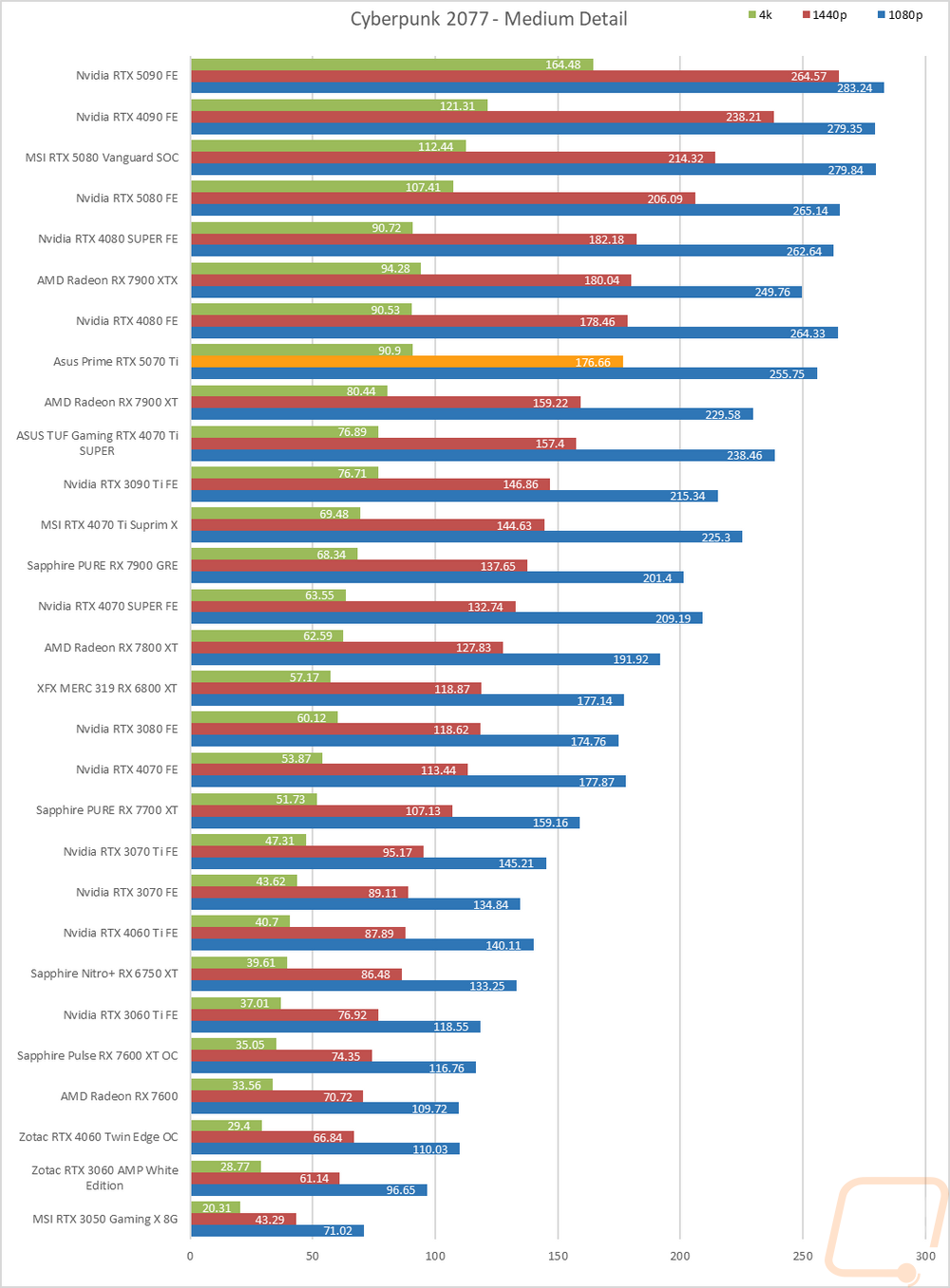Now we finally get into the in game performance and that is the main reason people pick up a new video card. To test things out I ran through our new benchmark suite that tests 8 games at three different resolutions (1080p, 1440p, and 4k). Most of the games tested have been run at the highest detail setting and a mid-range detail setting to get a look at how turning things up hurts performance and to give an idea of whether turning detail down from max will be beneficial for frame rates. Cyberpunk 2077 is also tested with Super Sampling (DLSS/FSR/XeSS). In total, each video card is tested 60 times and that makes for a huge mess of results when you put them all together. To help with that I like to start with these overall playability graphs that take all of the results and give an easier-to-read result. I have one for each of the three resolutions and each is broken up into four FPS ranges. Under 30 FPS is considered unplayable, over 30 is playable but not ideal, over 60 is the sweet spot, over 120 FPS is for high refresh rate monitors, and 240 helps show the performance ideal for the latest higher refresh displays.
So how did the Prime RTX 5070 Ti do? First, we should understand that Nvidia has the 5070 Ti targeted at 1440p which is why it has the same memory capacity as the RTX 5080. That said in our tests the Prime RTX 5070 Ti had each of the 1080p results come in over 120 FPS with 10 of the 17 results over 240 FPS. 1440p was similar as well with all of the results up over 120 FPS but at 1440p 8 of the results were over 240 FPS. Then when we get to 4k we hit a wall and you can see how some tests still do well, two were over 240 FPS at 4k and over 120 FPS had the most results with 9. That said at 4k we finally see some results in the 60-119 range with 5 and even one result that was under 60 FPS. 4k was still playable, but you can throw anything at the Prime RTX 5070 Ti at 1440p or 1080p but you might have to adjust things at 4k.



To get a better look at some of the cards that are the closest competition to the Prime RTX 5070 Ti and given what I saw in our synthetic tests I was a little unsure what I would end up seeing. In the synthetic tests the Prime RTX 5070 Ti performed ahead of the RTX 4080 SUPER in the DX11 tests and anything with ray tracing but in the pure DX12 tests it was even or below it. With our in-game tests, I do have two results that utilize DLSS but a majority don’t. The Prime RTX 5070 Ti did well, sitting above the 4080 SUPER at 1440p by 10 FPS and 7 at 4k. The RX 7900 XTX does still edge it out at 1440p and especially at 4k however.
|
|
1080p |
1440p |
4K |
|
AMD Radeon RX 7900 XTX |
257.44 |
225.83 |
145.67 |
|
Prime RTX 5070 Ti |
275.76 |
224.58 |
138.82 |
|
Nvidia RTX 4080 SUPER FE |
256.52 |
214.92 |
133.01 |
|
Nvidia RTX 4080 FE |
254.01 |
210.55 |
130.02 |
|
AMD Radeon RX 7900 XT |
243.12 |
203.66 |
122.55 |
|
Nvidia RTX 3070 Ti FE |
155.48 |
118.82 |
71.31 |
Of course, I have all of the actual in game results as well for anyone who wants to sort through the wall of graphs below. It’s interesting because going through these charts we see the Prime RTX 5070 Ti sometimes out in front of both the RTX 4080 and RTX 4080 SUPER but in other tests, it comes in on par or below them. Beyond that, our averages hold true.














Another new addition to my testing was a few additional tests using Cyberpunk 2077. This is one of only a few games that support most of the tech from all three of the GPU companies. So I did tests at medium and ultra detail while having Super Sampling on for all of the cards. Using whatever the latest and greatest is supported. In this case, I tested with DLSS and again with frame generation turned up to x4 as well. Just a note here, the AMD cards only allowed FSR when running windowed mode whereas Nvidia only performed well in fullscreen mode. So did these tests show us anything? Well in the base Medium detail test we see the Prime RTX 5070 Ti sitting just behind both the RTX 4080 and RTX 4080 SUPER but when the detail is turned up the Prime RTX 5070 Ti moves back in front of them both. Turning super sampling on that gap grows but we do see the 7900 XT and XTX jump up in the chart there. Switching to frame generation x4 changes things, so much in fact that I had to put them in their own chart to keep the results from breaking the chart. At ultra detail, the Prime RTX 5070 Ti at 4k goes from 58.72 FPS up to 172.35 with frame generation x2 and 280 with it set to x4.







